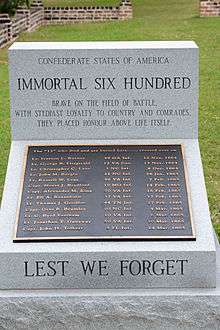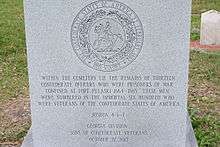Immortal Six Hundred
The Immortal Six Hundred were 600 Confederate officers who were held prisoner by the Union Army in 1864-65. They were intentionally starved and 46 died as a result. They are known as the "Immortal Six Hundred" because they refused to take an oath of allegiance to the U.S. under duress.
History


In June 1864, the Confederate Army imprisoned five generals and forty-five Union Army officers in the city of Charleston, South Carolina, using them as human shields in an attempt to stop Union artillery from firing on the city.[1] In retaliation, United States Secretary of War Edwin M. Stanton ordered fifty captured Confederate officers, of similar ranks, to be taken to Morris Island, South Carolina, at the entrance to Charleston Harbor. The Confederates were landed on Morris Island late in July of that year.
The Confederates had originally contended that Charleston should not be shelled. The correspondence between Major General John G. Foster, commanding the Federal Department of the South, and Major General Samuel Jones, commanding the Confederate Department of South Carolina, Georgia, and Florida, indicates the Confederates subsequently accepted the military nature of Charleston as a target. Soon the correspondence turned to an exchange of these high-ranking prisoners.[2]
Instructions from the War Department reached Foster in late July, and he coordinated an exchange of the fifty prisoners on July 29. Exchange of the fifty officers actually took place on August 4, 1864.[3] However, at that time Jones brought 600 additional prisoners to Charleston, in part to press for a larger prisoner exchange. In retaliation for the treatment of Federal prisoners, Foster asked for a like number of Confederate prisoners to be placed on Morris Island. These men became known in the South as the Immortal Six Hundred.
At one point General Foster planned an exchange of the six hundred, but General Ulysses S. Grant, who had previously terminated all prisoner of war exchanges due to Confederate mistreatment of captured United States Colored Troops,[4] wrote, "In no circumstances will he be allowed to make exchanges of prisoners of war ."[5]
I have seen from Southern newspapers that a system of retaliation is going on in the South which they keep from us and which we should stop in some way. On the subject of exchanges, however, I differ from General Hitchcock. It is hard on our men held in Southern prisons not to exchange them, but it is humanity to those left in the ranks to fight our battles. Every man we hold, when released on parole or otherwise, becomes an active soldier against us at once either directly or indirectly. If we commence a system of exchange which liberates all prisoners taken, we will have to fight on until the whole South is exterminated. If we hold those caught they amount to no more than dead men. At this particular time to release all rebel prisoners North would insure Sherman's defeat and would compromise our safety here. – General Ulysses S. Grant, August 18, 1864.
The Confederate prisoners did not arrive on Morris Island until the first week of September 1864. During the first week of October 1864, Jones (under orders from Lieutenant General William J. Hardee) removed the Federal prisoners from Charleston. Foster removed the Confederate prisoners from Morris Island only after being informed officially of the Federal prisoners' status. At that time the Immortal 600 were moved to Fort Pulaski.
Three of the six hundred died from subsistence on starvation rations issued as retaliation for the conditions found by the Union at the Confederate prisons in Andersonville in Georgia and at Salisbury Prison in North Carolina.[6]
Upon an outbreak of yellow fever in Charleston, the Union officers were removed from the city limits. In response the Union Army transferred the Immortal Six Hundred to Fort Pulaski outside of Savannah.[7]

There they were crowded into the fort’s cold, damp casemates. For 42 days, a "retaliation ration" of 10 ounces (280 g) of moldy cornmeal and 1⁄2 US pint (0.24 l; 0.42 imp pt) of soured onion pickles was the only food issued to the prisoners. The starving men were reduced to supplementing their rations with the occasional rat or stray cat. Thirteen men died there of diseases such as dysentery and scurvy.
At Fort Pulaski, the prisoners organized "The Relief Association of Fort Pulaski for Aid and Relief of the Sick and Less Fortunate Prisoners" on December 13, 1864. Col. Abram Fulkerson of the 63rd Tennessee Infantry Regiment was elected president. Out of their sparse funds, the prisoners collected and expended eleven dollars, according to a report filed by Fulkerson on December 28, 1864.
Five more of the Immortal Six Hundred later died at Hilton Head Island, South Carolina. The remaining prisoners were returned to Fort Delaware on March 12, 1865, where another twenty-five died.[6]
A notable escape effort was led by Captain Henry Dickinson of the 2nd Virginia Cavalry. On the prisoner's journey to Fort Delaware, Dickinson organized a group of thirteen officers, including Colonel Paul F. DeGournay of the 12th Battalion, Louisiana Artillery[8] and Colonel George Woolfolk, to try to escape from the gunboat. However, the effort failed when the captain of the ship, noticing that one of the 13 men was missing, led the prisoners to the brig below the deck of the ship.[9]
The prisoners became known throughout the South for their refusal to take the Oath of Allegiance under duress.[6] Southerners have long lauded their refusal as honorable and principled.[10]
References
- "Immortal 600: Prisoners Under Fire at Charleston Harbor During the American Civil War". HistoryNet. June 12, 2006.
- Correspondence between Foster and Jones. Source: Official Records, Ser I, Vol.XXXV, Pt.2, 132, 134, 143, and 174-5.
- Correspondence between Foster and Jones. Source: Official Records, Ser I, Vol.XXXV, Pt.2, 198.
- For example, section 7 of Congress of the Confederate States of America (May 1, 1863). "May 1, 1863 [No. 5.] – Joint Resolution on the Subject of Retaliation". Archived from the original on March 7, 2016. Retrieved October 13, 2016.
- General Grant to Secretary of War Stanton, regarding General Foster's planned exchange of the 600 Confederate officers for 600 Yankee prisoners of war. Source: Official Records, Ser I, Vol.XXXV, Pt.2, 254.
- "Fort Pulaski National Monument: Immortal 600 Living History Event". National Park Service. February 17, 2007. Retrieved April 4, 2009.
- "Fort Pulaski National Monument". National Park Service. Retrieved 2008-07-16.
- "Foreigners in the Confederacy" - Ella Lonn. 2002. UNC Press Books.
- "Immortal Captives: The Story of 600 Confederate Officers and the United States Prisoner of War Policy" - Mauriel Joslyn. 2008. Pelican Publishing.
- Savannah, Mailing Address: P. O. Box 30757; Us, GA 31410 Phone:786-5787 Contact. "Immortal 600 Living History Event - Fort Pulaski National Monument (U.S. National Park Service)". www.nps.gov.
Further reading
- Confederate Veteran Magazine, July 1909, Page 68
- Murray, Major John Ogden (1911). The immortal six hundred: A Story of Cruelty to Confederate Prisoners of War. Roanoke, VA: The Stone Printing and Manufacturing Company.
- Joslyn, Mauriel Phillips. Immortal Captives: The Story of 600 Confederate Officers and the U.S. Prisoner of War Policy., White Mane Publishing, 1996.
- Stokes, Karen. The Immortal 600: Surviving Civil War Charleston and Savannah, History Press, 2013.
External links
| Wikisource has original text related to this article: |